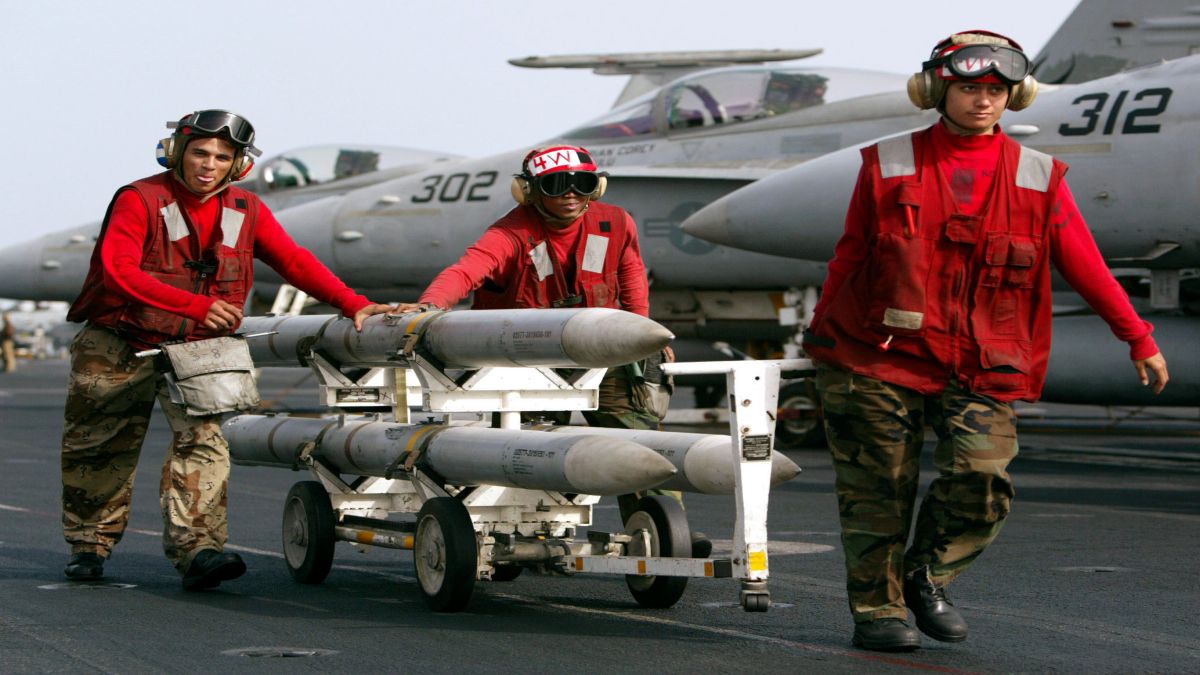The bromance between Pakistan and the United States keeps growing. After a rare earths deal and offering America the opportunity to build and operate a port in the Arabian Sea, Islamabad is reportedly being rewarded with Washington approving the sale of advanced air-to-air missiles to the Pakistan air force (PAF).
An arms contract recently notified by the US Department of War (DoW), formerly known as the Department of Defence, listed Pakistan among the 35 buyers for the missiles. The contract stipulates that Pakistan will receive 120D-3 Advanced Medium-Range Air-to-Air Missiles (AMRAAMs) by 2030.
This news triggers speculation about upgrades to the Pakistan air force’s (PAF) F-16 fleet. The AMRAAM is compatible only with the F-16s operated by the PAF and was reportedly used in 2019 to down an Indian Air Force MiG-21 flown by Wing Commander Abhinandan Varthaman.
Capabilities of the AMRAAM missile
The AIM-120 missile that the US will be selling to Pakistan is a highly advanced medium-range air-to-air missile developed by American defence giant, Raytheon.
The AMRAAM is a follow-on to the AIM-7 Sparrow missile series. The missile is faster, smaller and lighter, and has improved capabilities against low-altitude targets. It incorporates active radar with an inertial reference unit and micro-computer system, which makes the missile less dependent upon the fire-control system of the aircraft.
Once the missile closes on a target, its active radar guides it to intercept. This enables the pilot to aim and fire several missiles simultaneously at multiple targets. The pilot may then perform evasive manoeuvres while the missiles guide themselves to their targets.
The missile, according to Raytheon, is compatible with the F-15A/B/C/D/E Eagle/Strike Eagle, F-16 Fighting Falcon, F/A-18 Super Hornet, F-22 Raptor, Eurofighter Typhoon, JAS-39 Gripen, Tornado, and Harrier jets. Additionally, the newest AMRAAM version is also operational on all F-35 Joint Strike Fighter variants.
The US-made AMRAAM missile is a versatile piece of weaponry, offering air-to-air and surface-launch engagements. In the air-to-air role, the weapon’s advanced active guidance section and mature seeker design allow it to quickly find targets in the most challenging environments. In the surface-launch role, it is the baseline weapon on NASAMS, allowing countries to use the same missile in either role with no modifications.
As of today, the AMRAAM missile has been bought by 40 countries across the world, including Pakistan, Poland and Germany.
US’ sale of AMRAAM missiles to Pakistan
As per defence publication Quwa, the US will be supplying Pakistan with the AIM-120C8 missile, which is the export version of the AIM-120D, the main AMRAAM variant in US service.
Currently, the Pakistan air force operates the earlier C5 variant, 500 of which were acquired alongside its latest Block 52 F-16s in 2010. In fact, top defence sources have been quoted as saying that Pakistan has long been lobbying for the acquisition of these new-generation AMRAAMs to replace its ageing AIM-120C-5 variants. This gathered more speed, as India continues to make its own strides in its military capabilities with the induction of Rafale jets equipped with Meteor missiles.
And the US’ decision to sell the missiles comes after a series of high-level meeting held in July when Pakistan air force Chief Air Marshal Zaheer Ahmed Baber Sidhu met senior US military and political leaders in Washington.
Notably, the AMRAAM missile has been one of Pakistan’s most prominent and deadliest piece of military equipment. Islamabad had bought over 700 of the missiles in 2007, making it the largest international order for the weapon at the time.
Later, in 2019, Pakistan used the F-16 and the AMRAAM missile to shoot down Indian military installations in Jammu and Kashmir. This was thwarted by the Indian Air Force, which lost a MiG-21 Bison and its pilot, Wing Commander Abhinandan Varthaman was captured. He was later handed over to India.
At the time, India had given proof to the US about the use of F-16 fighters and AMRAAM beyond visual range air-to-air missile by Pakistan, stating that it violates the US stipulated rules for both — the jet and the missile.
A concern for India
The US sale of the AMRAAM missile is likely to be a worry for India, as it reflects America’s deepening friendship with Islamabad at the expense of New Delhi. Since US President Donald Trump has returned to the White House, he has been strengthening Pakistan-US ties , which only became stronger after India’s Operation Sindoor in May.
Pakistan credited US President Donald Trump for arranging a ceasefire and topped it by proposing his name for the Nobel Peace Prize. Meanwhile, India has consistently maintained that the understanding on cessation of hostilities with Pakistan was reached following direct talks between the Directors General of Military Operations (DGMOs) of the two militaries.
Moreover, Trump met Pakistani Prime Minister Shehbaz Sharif and his Army chief Field Marshal Asim Munir in September at the Oval Office where both sides lavished praise on each other. On the other hand, the US, under Trump, has levied heavy tariffs on India — a total of 50 per cent.
With this new contract, the US is improving Pakistan’s aerial capabilities, which could cause apprehension for India in case of another face-off with Islamabad.
Moreover, Pakistan’s purchase of the AMRAAM missile comes at a time when it is already purchasing a large number of weaponry from China . In Operation Sindoor, Pakistan deployed many China-made weapons such as the PL-15 beyond visual range air-to-air missile as well as the HQ-9 air-defence system. In fact, according to a SIPRI report, Chinese arms made up 81 per cent of Pakistan’s weapons imports in the past five years.
This should concern India as it shows that Pakistan is continuously expanding its defence imports and trying to rope in more defence partners.
It is left to be seen what comes next, but one thing is clear — the US-Pakistan partnership is only growing from strength to strength and India should watch out.
With inputs from agencies
)